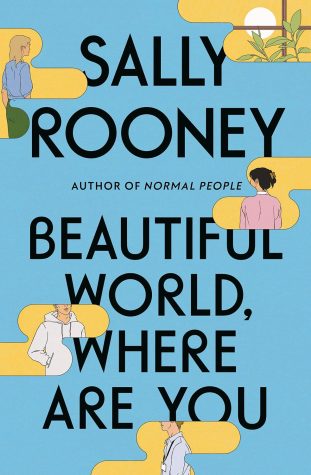BOOK CLUB: ‘Beautiful World, Where Are You’ is a realistic yet hopeful reflection of modern life
The Seahawk’s September book club pick “Beautiful World, Where Are You” is the perfect existential read to curl up with this fall. If you enjoy realistic fiction centered around interpersonal relationships, this novel is for you. Exploring themes of friendship, romance and humanity, “Beautiful World, Where Are You” offers an intimate look into what makes us tick.
“Beautiful World, Where Are You” is the third novel in beloved Irish author Sally Rooney’s bibliography. Released on Sept. 7, 2021, it quickly rose to number one on the New York Times bestseller list. That same year, the novel received the Irish Book Award for Novel of the Year and Goodreads Choice Award for Best Fiction. “Beautiful World, Where Are You” is widely considered Rooney’s best work yet. Considering the popularity of her previous two novels, “Normal People” and “Conversations with Friends,” that is high praise indeed.
“Beautiful World, Where Are You” lives up to its reputation. Simply put, the plot revolves around four main characters—Alice, Felix, Eileen and Simon—and the way their lives intersect. In the Irish countryside, Alice, a famous writer recently released from a mental hospital, meets the aloof warehouse worker Felix on a dating app. In Dublin, Eileen, a disillusioned magazine editor, reencounters her childhood friend and long-time love Simon. As both women navigate their romantic relationships, they share their struggles over email and muse on modern society’s condition. Thus, Alice and Eileen explore, individually and together, the question asked in the book’s title.
In another author’s hands, this premise might seem lifeless, but Rooney has a knack for making an everyday conflict interesting. She does so in this novel by choosing to focus on specific character development. Each of the main four is incredibly distinct, with their similarities and differences made more so by contrast. While Alice is unpredictable and intense, Eileen ends to play it safe. While Felix is brutally honest, Simon struggles to vocalize his feelings. These qualities play out in both positive and negative ways in their relationships too, making the four characters all the more real and relatable.

Their flaws are not detrimental to the reader’s emotional investment, but rather contributory. As readers come to know and care for the characters, their seemingly ordinary interactions become more and more interesting. This contributes to the novel’s greatest strength—its mimicry of real life.
An imitation of life is not complete, though, without zooming out on the world in which the characters live. Rooney, for example, accomplishes this by splitting narrative style. Most of the novel is told in third person omniscient, but several chapters are framed as emails sent between Alice and Eileen. This strategy gives the pair room to express more intimate thoughts and opinions.
Besides furthering their characterization, Rooney also uses this strategy to bring a broader perspective into the narrative. Alice and Eileen discuss climate change, capitalism, the effects of fame and world history throughout their many emails together. As they explore their questions about the viability of humanity’s future, Rooney leads the reader to ask the same ones.
There is something to be said about these when considering the characters’ backgrounds. For the most part, Alice and Eileen do not seem to have any specific obstacles preventing them from progressing in society, besides what already hinders everyone else. Alice complains about the demands of her job without considering how wealthy she is because of it. Eileen complains about the capitalistic system without any thought as to how she benefits from it more than others.
At times, this makes their email exchanges feel self-indulgent. However, that also contributes a sense of realism to the novel—the ways that reality and opinions can sometimes clash, as well as a reiteration of the characters’ acknowledged flaws.
Rooney does use these discussions, however, to make a pointed statement. Alice and Eileen never arrive at definite answers to their questions about society. Instead, as they navigate their pasts, current personal lives, and their email discussions, they arrive at an unexpected conclusion—that despite humanity’s seemingly inevitable doom, relationships with each other are what make life meaningful. Rooney demonstrates this fact in the narrative, as well, as the two couples progress in their relationships.
In the end, “Beautiful World, Where Are You” presents a hopeful narrative. Rooney makes a surprisingly strong choice to conclude the novel at the start of the pandemic, integrating the hopeful message into current events.
While many readers do enjoy Rooney’s novels, her writing style in this novel may be a hindrance to the casual reader. The narration contains little significant action, resorting to looking, turning, sighing, and other subtle behaviors. This contributes in earlier chapters to the feeling that little is happening. The dialogue is also presented within the narration, making it occasionally difficult to identify who is speaking.
Though these are not fatal flaws, actually contributing to the tone of the novel, they may make readers lose interest early on. However, it is worth pushing through as the narrative blossoms into a singularly profound experience.
A novel rooted in reality, “Beautiful World, Where Are You” unearths what it means to be human within our modern context.







